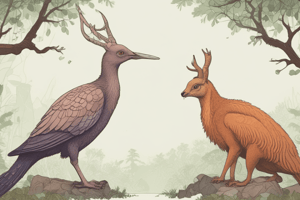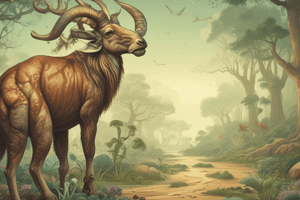Podcast
Questions and Answers
What is the primary objective of the maximum likelihood method in phylogenetic inference?
What is the primary objective of the maximum likelihood method in phylogenetic inference?
- To minimize evolutionary changes among species
- To determine the most ancestral state of species
- To provide the absolute evolutionary history of species
- To evaluate the probability of observing data under a given model (correct)
Which method assumes prior distributions for trees and model parameters?
Which method assumes prior distributions for trees and model parameters?
- Maximum likelihood
- Bayesian inference (correct)
- Cladistics
- Parsimony
Which approach is favored under the parsimony criterion when analyzing phylogenetic relationships?
Which approach is favored under the parsimony criterion when analyzing phylogenetic relationships?
- Tree C
- Tree B
- Tree A (correct)
- None of the trees are favored
What problem does gene tree-species tree discordance primarily address?
What problem does gene tree-species tree discordance primarily address?
In the context of deep evolutionary history, which statement regarding mitochondrial DNA is true?
In the context of deep evolutionary history, which statement regarding mitochondrial DNA is true?
What can genome scale data often help infer regarding species?
What can genome scale data often help infer regarding species?
What does topological discordance in gene trees indicate?
What does topological discordance in gene trees indicate?
Which method seeks to identify general patterns of evolution?
Which method seeks to identify general patterns of evolution?
What assumption does treating each species as an independent data point resemble?
What assumption does treating each species as an independent data point resemble?
What is a critical factor in the comparative methods of evolution?
What is a critical factor in the comparative methods of evolution?
What is a potential cause of gene tree-species tree discordance?
What is a potential cause of gene tree-species tree discordance?
In studying deep evolutionary history, what does the term 'phylogeny' refer to?
In studying deep evolutionary history, what does the term 'phylogeny' refer to?
Which of the following is not typically a focus of comparative methods in evolution?
Which of the following is not typically a focus of comparative methods in evolution?
What is a primary use of phylogenetic analysis in evolutionary biology?
What is a primary use of phylogenetic analysis in evolutionary biology?
What constitutes a character in phylogenetic analysis?
What constitutes a character in phylogenetic analysis?
Why is identifying homologous characters important in phylogenetic methods?
Why is identifying homologous characters important in phylogenetic methods?
What challenges can arise from sequence alignment in phylogenetic analysis?
What challenges can arise from sequence alignment in phylogenetic analysis?
How does phenetic or distance-based methods help in inferring evolutionary relationships?
How does phenetic or distance-based methods help in inferring evolutionary relationships?
Which of the following statements is true regarding character states?
Which of the following statements is true regarding character states?
What does the concept of convergent evolution imply?
What does the concept of convergent evolution imply?
What are taxa in the context of phylogenetic analysis?
What are taxa in the context of phylogenetic analysis?
Which of the following is NOT a property explored through phylogenetic analysis?
Which of the following is NOT a property explored through phylogenetic analysis?
What type of traits can comprise characters in phylogenetic studies?
What type of traits can comprise characters in phylogenetic studies?
Flashcards
Genome-scale data
Genome-scale data
Data from an entire genome used to infer species relationships.
Species tree
Species tree
A branching diagram showing the evolutionary relationships among species.
Topological discordance
Topological discordance
Inconsistencies in the inferred evolutionary relationships among species based on gene trees.
Comparative Method
Comparative Method
Signup and view all the flashcards
Correlated evolution
Correlated evolution
Signup and view all the flashcards
Temporal patterns of trait evolution
Temporal patterns of trait evolution
Signup and view all the flashcards
Star phylogeny
Star phylogeny
Signup and view all the flashcards
Independent data points
Independent data points
Signup and view all the flashcards
Parsimony Criterion
Parsimony Criterion
Signup and view all the flashcards
Maximum Likelihood
Maximum Likelihood
Signup and view all the flashcards
Bayesian Inference
Bayesian Inference
Signup and view all the flashcards
Prior Distributions
Prior Distributions
Signup and view all the flashcards
Node Probabilities
Node Probabilities
Signup and view all the flashcards
Phylogenetic Analysis
Phylogenetic Analysis
Signup and view all the flashcards
Taxa
Taxa
Signup and view all the flashcards
Characters
Characters
Signup and view all the flashcards
Character States
Character States
Signup and view all the flashcards
Homologous Characters
Homologous Characters
Signup and view all the flashcards
Sequence Alignment
Sequence Alignment
Signup and view all the flashcards
Convergent Evolution
Convergent Evolution
Signup and view all the flashcards
Phenetics
Phenetics
Signup and view all the flashcards
Distance-Based Methods
Distance-Based Methods
Signup and view all the flashcards
Recent Common Ancestor
Recent Common Ancestor
Signup and view all the flashcards
Study Notes
Phylogenies and their Uses
- Phylogenies reconstruct life's history.
- They are useful from an organismal perspective.
- Phylogenies help detect evolutionary patterns.
- They show which traits are older and younger.
- Traits correlated during evolution are identified.
- Traits linked to lifestyles and ecology are revealed.
- Ancestral biological properties are studied.
Phylogenetic Approaches
- Phylogenies are foundational tools in evolutionary biology.
- The Tree of Life Web Project provides information about diverse organisms, their evolutionary history, and characteristics.
- The project displays hierarchical links between organisms, illustrating genetic relationships from the root of life to individual species.
Phylogenetic Analysis
- Taxa are basic units of analysis, ranging from individuals to higher levels (genera, phyla).
- Characters can encompass DNA sequences to complex traits.
- Character states are distinguished from characters themselves (e.g., nucleotide 4 can be either G or A).
- Characters can have states defined by numbers of traits (e.g., dorsal fin rays).
- Phenotypic traits can be discrete or continuous.
Homologous Characters
- Phylogenetic methods require identifying homologous characters (traits shared due to common ancestry).
- Sequence alignments between species illustrate hypotheses about nucleotide homology and evolutionary relationships.
Problems in Phylogenetic Analysis
- Alignment is often challenging, significantly influencing phylogenetic inference.
- Convergent or parallel evolution may lead to problems in determining ancestral relationships.
Phenetics and Distance-based Methods
- Phenetics and distance-based methods compare sequence data to infer evolutionary relationships.
- Organisms more similar likely share more recent common ancestors.
- Evolutionary rates across lineages are presumed to be homogenous.
Cladistics
- Cladistic analysis reconstructs branching patterns using shared derived character states (synapomorphies).
- All traits share a common ancestor.
- A shared derived character state can only arise from a common ancestor.
- Monophyletic groups are the only valid groupings, containing all relatives of a common ancestor.
Inferring Ancestral Character States
- Data from the fossil record can assist in determining character states if preserved in earlier fossils.
- Incompletely preserved fossil records can yield incorrect inferences.
- Using fossil record for determining character states is not applicable to all taxa.
- Developmental biology may help infer ancestral states.
- Derived states might appear late in development compared to ancestral states.
Methods for Determining Character State Polarity
- The outgroup method compares a species' character to that of a closely related species (outgroup) presumed to represent the ancestral state.
- This method assumes that the outgroup's character represents the ancestral state, which may not always be accurate.
- Different outgroups may give conflicting ancestral state inferences.
Studying That Suits You
Use AI to generate personalized quizzes and flashcards to suit your learning preferences.




